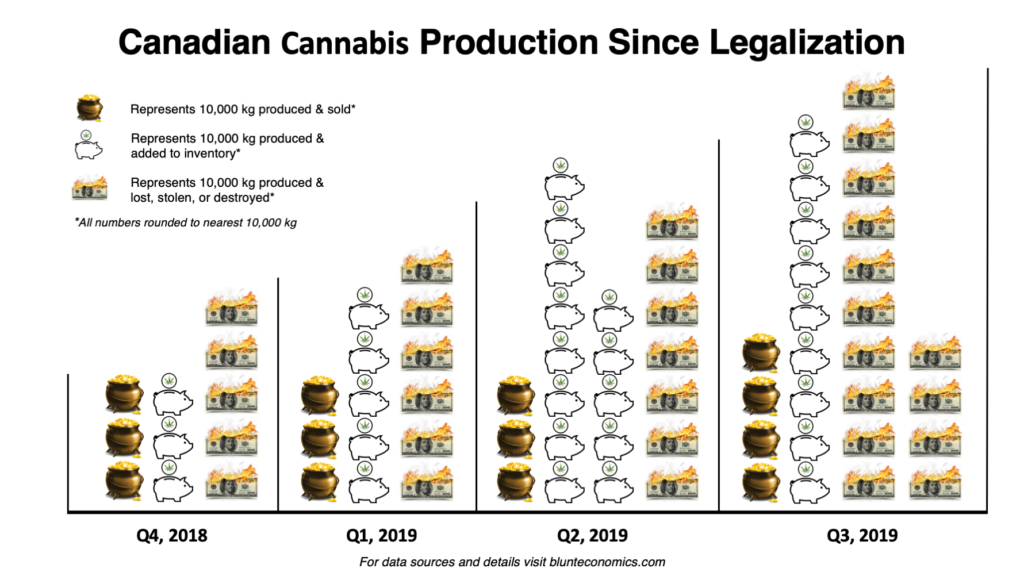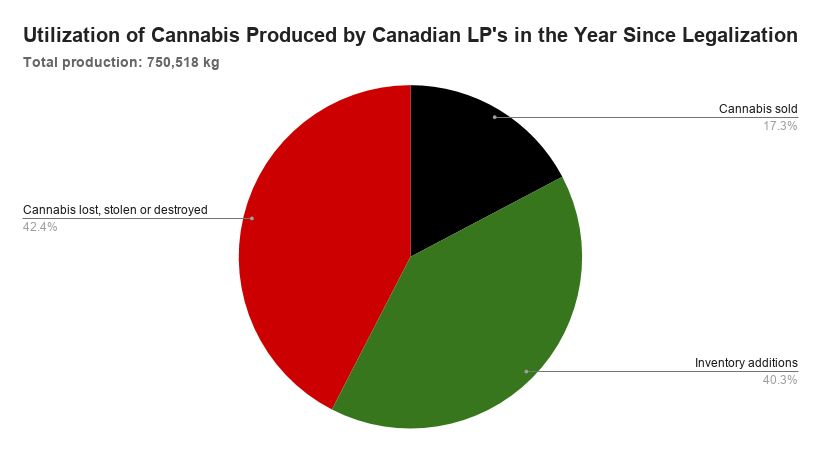Health Canada recently updated their cannabis market data, adding new data that allow you to calculate the amount of cannabis that was lost, stolen, or destroyed by Canadian Licenced Producers (LPs). It’s a doozy.

During the last year 318,000 kg of cannabis was lost, stolen, destroyed, or otherwise disappeared.
In my last post, I talked about the astonishing extent to which Canadian cannabis companies have over-invested in production capacity. About 16% of weed sold in Canada was sold in the legal market, and the total Canadain market (legal and black-market combined) was about 788,000 kg. Nevertheless, Canadian LPs have built and licensed enough production space to grow more than 2,460,000 kg of cannabis; that’s more than 3.5 times the size of the total Canadian cannabis market and more than twenty times the amount that was sold this past year in the legal market.
To put that in context: if the legal market doubles in size, then doubles in size again, then doubles in size again after that, then doubles in size still one more time, Canadian LPs could have stopped increasing production capacity back in September 2019 and would still have 35% more capacity than necessary. (Note: this capacity number is higher than I reported in the last post; it’s based on the most recent data available.)
Regardless of how much Canadian LPs could possibly ever sell, they still used a surprising amount of the available production capacity. From October 1st, 2018 to September 30th, 2019, Canadian LPs grew a little more than 750,000 kg of weed, with production ramping up over time. They grew as much as was sold legally over the whole year (~130,000 kg) in just the last month and a half of that period (mid-August to the end of September 2019).
After selling all the weed they possibly could, what did Canadian LPs do with the rest? They squirreled away a lot of it. But it seems like the majority of it, they just destroyed.
After selling all they possibly could, what did Canadian LPs do with the rest? They squirreled away a lot of it. Inventories ballooned by more than 300,000 kg. But it seems like the majority of it, they just destroyed. During the last year, 318,000 kg of cannabis was lost, stolen, destroyed, or otherwise disappeared. Based on the most recent spot price for wholesale cannabis in Canada ($6.62/gram), that’s north of $2.1 Billion dollars worth of weed. (Note: that’s the price received by producers; retail prices are considerably higher.)
To my knowledge, the data required to know what percentage was lost, what was stolen, and what was destroyed is not publically available. My assumption is that most of it was destroyed. But who knows? All I can tell you with certainty is this: The weed’s gone.

Data Details and Sources
I’ve posted the data in a Google Sheet document. It’s a view-only document, which will allow you to view the formulas used. If you want to play around with the data, you can download it as an Excel sheet or save it to your own Google drive. Although the specific calculations I used are available on that sheet, the overall idea behind the numbers is straightforward and worth being clear about here.
At any given time, the cannabis inventory in the LP system consists of dried cannabis (see Health Canada’s dry cannabis data) and cannabis oil (see cannabis oil data), which was obviously made from cannabis grown by LPs. About 5 mL of oil can be made from the same cannabis required to produce 1 gram of dried cannabis. Therefore, you can look at all inventory in the system in terms of kilograms of dried cannabis and the dried cannabis equivalent of oil. (The 5 mL/g conversion rate is the same used by Bloomberg, an example of which can be found here.)
Changes in inventory from one period to the next are the net result of all additions to inventory and all reductions to inventory over that period.
The only addition to the LP system inventory comes from cannabis production: growing and drying cannabis within the LP system. Importantly, converting dried cannabis to cannabis oil doesn’t add new material into the system; it just changes its form. Similarly, transfers from one LP to another do not change the level of inventory in the LP system (they just move it from one place to another). In Health Canada’s data, this addition to the LP system is reported within the section on dried cannabis under “unfinished production”.
The only reductions in LP system inventory that are reported by Health Canada are monthly sales. This includes medical and recreational sales of both dried cannabis and oil. My main interest here is obviously all the other reductions. I calculated this by starting with monthly production and subtracting 1) changes in reported inventory; 2) sales. Again, the details and links to the original Health Canada data can all be found on the Google Sheet linked above.